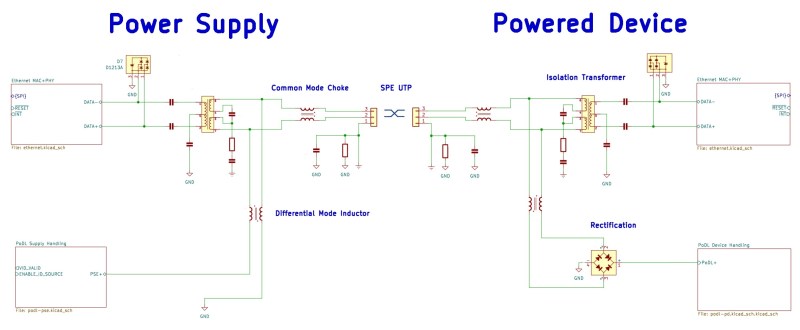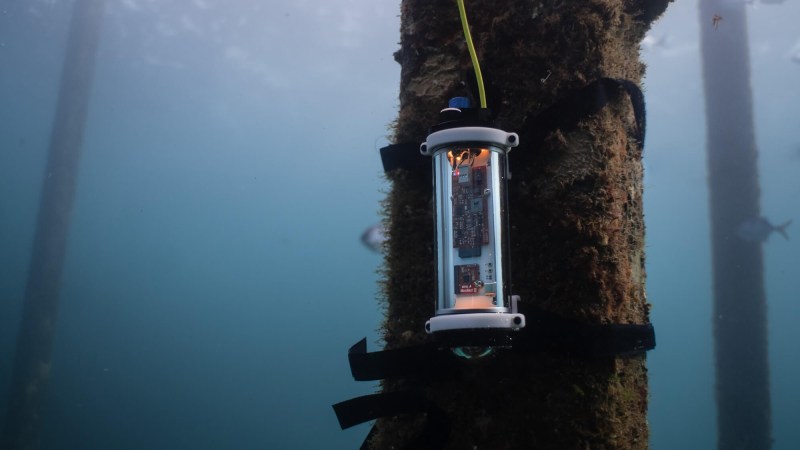The 10BASE-T1 Ethernet standard is also known as ‘single pair Ethernet’ (SPE), as it’s most defining feature is the ability to work over a single pair of conductors. Being fairly new, it offers a lot of advantages where replacing existing wiring is difficult, or where the weight of the additional conductors is a concern, such as with the underwater sensor node project that [Michael Orenstein] and [Scott] dreamed up and implemented as part of a design challenge. With just a single twisted pair, this sensor node got access to a full-duplex 10 Mbit connection as well as up to 50 watts of power.
The SPE standards (100BASE-T1, 1000BASE-T1 and NGBASE-T1) 10BASE-T1 can do at least 15 meters (10BASE-T1S), but the 10BASE-T1L variant is rated for at least 1 kilometer. This makes it ideal for a sensor that’s placed well below the water’s surface, while requiring just the single twisted pair cable when adding Power over Data Lines (PoDL). Whereas Power-over-Ethernet (PoE) uses its own dedicated pairs, PoDL piggybacks on the same wires as the data, requiring it to be coupled and decoupled at each end.

Within the PoDL standard there are sixteen supported power classes along with a compatibility matrix for 10XXBASE-1T standards. Detecting of a PD-compatible device is done by the power supply providing a constant current source and the powered device sinking current to adjust the voltage to hit a specific level. With all of this knowledge and the requisite parts in mind and hand, a waterproof enclosure was sourced, firmware written and everything assembled to create a sensor node for temperature, humidity (SHTC3), motion (LSM6DSO) and depth/pressure (MS5837).
So that’s power and communications settled. All of a sudden, that homebrew ROV you’ve been dreaming of is starting to look a little more achievable.

















>Whereas Power-over-Ethernet (PoE) uses its own dedicated pair
Yes, but only with 100M.
The big advantage of SPE is the single pair, saving 2 wires compared to “normal” Ethernet.
SPE saves 6 wires compared to “normal” ethernet. For the ROV use case that means a significantly lighter and more flexible tether.
It saves 6 wires compared to normal ethernet cabling. Typically, only two of the four pairs have been used for ethernet (gigabit notwithstanding).
I always found it interesting that we always had to install four pairs to do a two pair job, and at the same time it was heavily frowned upon if we were to employ a spare pair if one of the other pairs went bad.
I have seen two connections running on a single “split” four pair cable. I never really looked to see how well they were running. It’s hard to determine such things when one is looking the other way.
I’ve run many single cable to the desktop runs. 2 pair for ethernet, 1 pair for phone. Saved a few miles of cape that way. Not to mention a few conduits that would have been awfully tight otherwise.
Wondering why a humidity sensor, wouldn’t it always be 100% under water?
I think they’re ignoring the humidity, the most widely available off the shelf temperature sensors for hobbyists include it for free. Having said that, it might also be useful for detecting leaks, since the internals of the sensor should be a lot less than 100% RH
Probably to check if the enclosure is leaking.
Power over Ethernet does not need its own dedicated pairs. Power over Ethernet works with 2 or 4 pair base-t Ethernet and MAY provide the power over the ‘spare pairs’ in 2 pair Ethernets, but can also provide power on the same pairs as data. See https://ethernetalliance.org/wp-content/uploads/2019/12/WP_EA_Overview8023bt_V2p1_FINAL.pdf for details
Neat, it is 4PPOE but for SPE. They missed the chance to confuse people and call it 2PPOE.
Especially because it wouldn’t be 2PPOE but 1PPOE
It’s also called SPoE. Turns out the ‘PoDL’ name was cute but too generic…
I was right and the elder geek (my dad) was wrong. We disagreed 20 years ago on eventual feasibility.
Now I’m imagining basically a floating apple Airport with some batteries as the surface station for an ROV.
Underwater you could use a single cable and use the water as a return path. Maybe.
I do wonder why they need a humidity sensor underwater, though?
If you have a leak, the humidity goes up rapidly.
It will also change as a function of temperature.
I don’t get this article.
– It barely goes into the underwater sensor node
– it’s just wrong @”Whereas Power-over-Ethernet (PoE) uses its own dedicated pairs” (false for at least half of the different PoE modes).
– doesn’t explain single-pair full-duplex(!) Ethernet at all
What remains is … nothing?
The damn schematic is more interesting and useful than the whole article.
I mean the capacitors splitting the signal transformers on both sides (of the cable)? I’m sure that’s not how “normal” 2/4 pair Ethernet works – but maybe a core part of the full-duplex capability?
It’s half duplex with some sort of collision avoidance system (everyone gets a turn, like Token Ring or Arcnet). Want to know how I know that? I clicked on the link in this article on the standards, and watched a video there. If you want to know about the sensor project, you could probably click on that link too.
The 10BASE-T1S is what the link refers to – that’s the 15m variant – but not the 10BASE-T1L which is what is described here. 10BASE-T1L, like 1000BASE-T and the higher speed ethernets used in LANs (2.5G/5G/10GBASE-T) is full duplex. They use adaptive echo cancellation to allow transmission to and reception from the link partner simulataneously. How do I know this? I chaired the standard, have built BASE-T Ethernet PHYs, and been involved in every wired Ethernet standard since 1000BASE-T in 2000.
So upon finding this thread and the good & clarifying Feb. 28 comment, I checked Collabratec (IEEE) and yeah, “been involved” is right.
The first Ethernet I used was 802.3b thicknet. To LAN developers’ relief, improvements came rapidly. Today’s PHYs are — to put it in technically rigorous jargon — way better. Thank you.
It’s a bit longer than it needed to be but a quick “hey, this single pair Ethernet tech exists now and it’s cool, for example in underwater systems” is a perfectly reasonable article. Also of note is that the stated purpose of the sensor is a tech demo for single pair Ethernet, so that being the focus makes sense rather than what is otherwise a pretty standard
Hmmm, single pair ethernet. Reminds me of ArcNet.
I so used to hope the price would go down on ArcNet adapters, back when there were recently disconnected phone lines everywhere.
We had single pair Ethernet over 30 years ago, albeit even more intricate. You see, the trick we knew then, but that this rediscovery doesn’t use, is that we put one of the pair’s conductors INSIDE the other. It was a rather elegant solution, though I’ll admit that it made the cables “robust”.
Wait… Is this a coax joke?
Why not use a powerline adapter like the openrov project does? That will give you enough bandwidth to stream video. Although that project does not use the cable for power delivery.
That seems like a lot of complexity, if you only want one pair of wires, why not just coax or even RS485?
I’m intrigued – how do you do single pair comms & power without complexity?
It’s really great to see these applications getting out. SPE and PoDL/SPoE are finding there way into places no one imagined when I chaired the IEEE 802.3cg standard that specified 10BASE-T1L and the new classes of PoDL/SPoE that go with it.